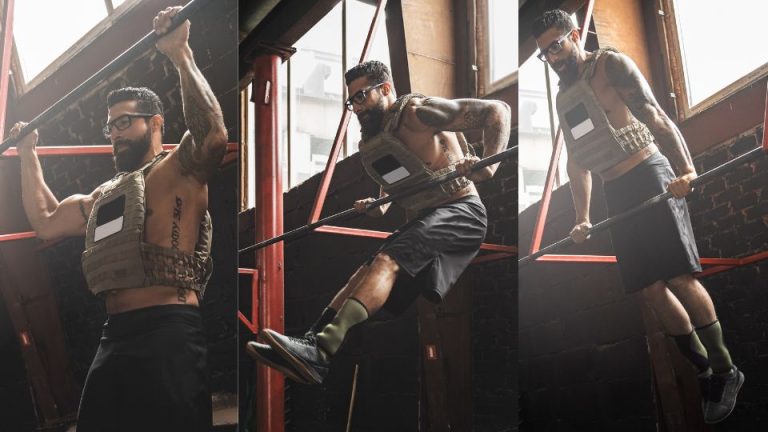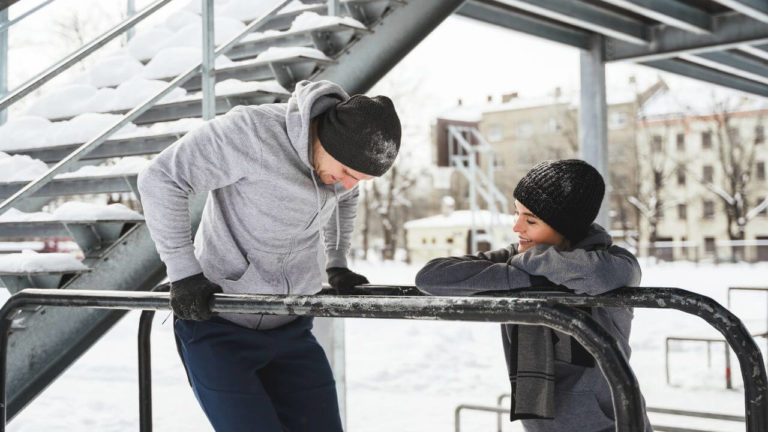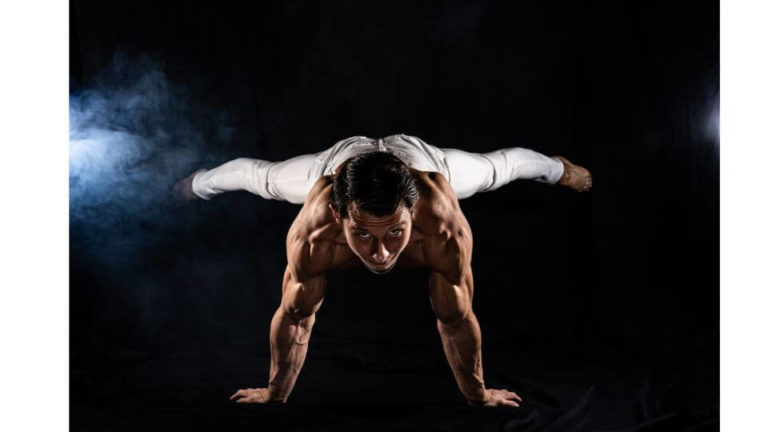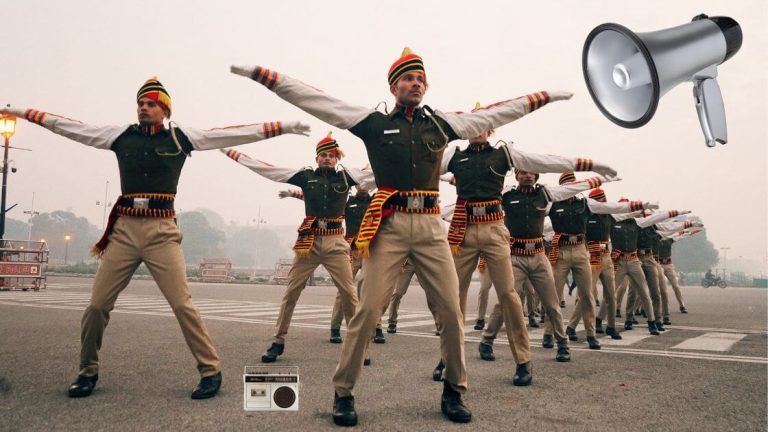Common Calisthenics Injuries in Shoulder, Wrist and Elbow – Symptoms and Treatment
If you seek progress in any field, you need to challenge yourself. When you push your limits the chance of injury increases. The injury rate in calisthenics is not higher than in any other sport discipline and it’s not what you do that gets you injured but how you do it. If you have common sense and follow our tips for beginners you will avoid senseless injuries and maximize the rate of return on the time and effort you invest in your workouts.
Calisthenics is based on functional exercises and movements that our body was meant to be doing by nature. Unfortunately, injuries happen, even against our best effort. They can stem from unprepared joints, broken form, overtraining, and several other reasons. We will cover some of them later in this article but it’s very important to do regular prehabilitation work, avoid unnecessary risk and do at least a quick but targeted warm-up before intense exercise.
What are some injuries that can happen in calisthenics?
Injuries in calisthenics most often happen in the shoulder and wrist joints and less frequently in the knee and lower back and are caused by overuse or trauma. Some of these injuries are:
- supraspinatus tendonitis (shoulder impingement)
- biceps tendonitis
- adhesive capsulitis (frozen shoulder)
- wrist sprain and fracture
- carpal tunnel syndrome (nerve compression)
- lateral epicondylitis (tennis elbow)
- medial epicondylitis (golfer’s elbow)
- lower back pain
- knee pain
Naturally, some level of discomfort is normal and you need to learn to differentiate pain that may lead to injury. A certain degree of pain is necessary for progression – for example while practicing an intense exercise or training to failure. That’s why it’s important to adjust the training intensity to your perceived recovery rate and level of strength. Pushing yourself too much too soon in your development process will eventually lead to an injury. Joint injuries take months to heal so your impatience may just further slow down your progress and ruin your training plan.
Shoulder injuries in calisthenics
When the shoulder joint is injured the reason can be overuse which happens over time due to a large volume of repetitive movement. This is more common for older athletes but anyone can be susceptible. Another common source of injury can be a traumatic event such as a fall or other impact e.g. a sudden bad move.
Overuse shoulder injuries are usually a result of inflammation of the rotator cuff tendon which – if left untreated – can lead to a completely torn tendon. When I had a rotator cuff injury, I did a few minutes of dead hangs 3-4 times per week and it helped me to heal within weeks instead of months. Obviously, each case can be different so I recommend talking to your doctor first.
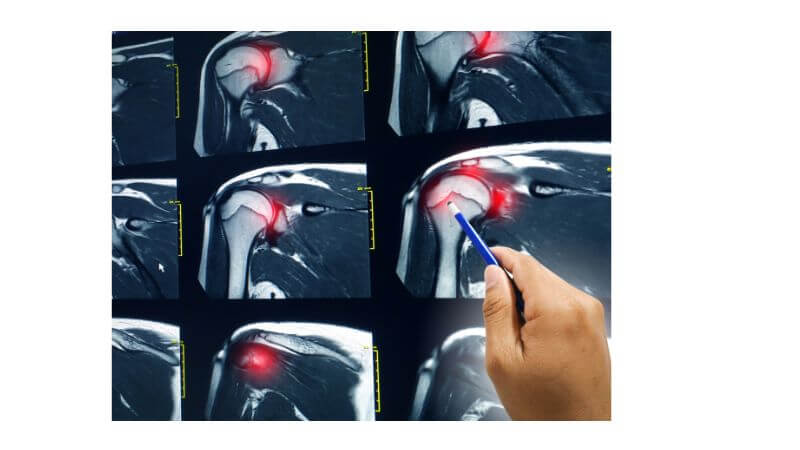
Supraspinatus Tendonitis
Also known as rotator cuff or shoulder impingement and is the most common type of shoulder injury in calisthenics. The supraspinatus tendon is one of the four tendons that make up the rotator cuff in the shoulder (the other ones are: Infraspinatus, Subscapularis, and Teres minor). Tendonitis is an inflammation of the tendon and is usually caused by a rubbing of the supraspinatus tendon against a bone called the acromion. As a result of this irritation, the tendon swells and as it grows the rubbing gets worse. This is why it’s important to stop training and give it time to heal. Symptoms include pain in the shoulder, especially when lifting the arm overhead or reaching behind the back.
Causes: Shoulder impingement can be caused by any overhead rotational movement that puts the shoulder joint in a compromised position such as pull-ups. The most common cause of supraspinatus tendonitis is overuse.
Treatment: Initial treatment typically involves rest, ice, and anti-inflammatory medications to reduce pain and inflammation. Physical therapy may also be recommended to improve shoulder strength and flexibility. In more severe cases, corticosteroid injections or surgery may be necessary.
Biceps Tendonitis
The biceps tendon attaches the biceps muscle to the shoulder and elbow joints. Biceps tendonitis is an inflammation of the long head of the biceps tendon. It usually goes hand-in-hand with other rotator cuff injuries. Symptoms include pain in the front of the shoulder, particularly with overhead movements or lifting weights.
Causes: Biceps tendonitis is often caused by overuse as a result of repetitive overhead movements or high-velocity motions.
Treatment: Healthcare professionals can treat biceps tendonitis through physiotherapy, chiropractic care, and other modalities like acupuncture or ultrasound. Massage therapy can also be used to address the surrounding structures around the long-head biceps tendon, with techniques applied to the neck, upper to mid-back, chest, and shoulder. Deep, specific techniques combined with shoulder movement can promote tissue mobility, decrease pain, and encourage blood circulation for the healing process. Cupping therapy may also be used to increase circulation and help the healing process.
Adhesive Capsulitis
Adhesive capsulitis, also known as “frozen shoulder”, is a condition that causes stiffness and pain in the shoulder joint. It can make it difficult to move the arm, particularly with overhead movements or reaching behind the back.
Causes: The exact cause of adhesive capsulitis is unknown, but it is believed to be caused by inflammation and thickening of the shoulder capsule, which surrounds and supports the shoulder joint. It can be caused by injury, prolonged immobilization, medical conditions such as diabetes, thyroid disorders, or heart disease, and it is more common in people over 40 years old and women.
Treatment: To diagnose a frozen shoulder, a physical exam, x-rays, and an MRI may be needed. Treatment focuses on relieving pain and restoring range of motion, with options such as anti-inflammatory medication, ice packs, corticosteroid injections, and physical therapy. Patients should avoid aggravating activities and diligently follow their exercise regimen, as recovery can take several months to years. Surgery is rarely required for persistent cases.
This is a great video that explains how to diagnose which of the above injuries you have at home.
Wrist injuries in calisthenics
Overuse injuries occur when repetitive microtrauma exceeds the tissues’ ability to adapt, causing molecular-level damage from tension or shear loads. The wrist and hand are particularly vulnerable to upper extremity overuse injuries from sports that involve repetitive movements and weight bearing. Accurate diagnosis requires understanding the mechanism of injury, activities, and MRI findings, which are crucial for accurate diagnosis and treatment.
- Sprains: A sprain is a common wrist injury that happens when the ligaments in the wrist are stretched or torn. It can be caused by falling on an outstretched hand, twisting the wrist, or repetitive motions. Symptoms of a sprained wrist include pain, swelling, and difficulty moving the wrist. Treatment includes rest, ice, compression, and elevation (RICE), immobilization with a splint or cast, and physical therapy.
- Fractures: A wrist fracture occurs when one or more of the bones in the wrist break. This can happen from a bad fall. Symptoms of a wrist fracture include pain, swelling, and difficulty moving the wrist. Treatment for a wrist fracture includes immobilization with a cast or splint, pain management, and physical therapy.
- Carpal tunnel syndrome: Carpal tunnel syndrome is a wrist injury that occurs when the median nerve in the wrist is compressed. It can be caused by repetitive motions or underlying medical conditions. Symptoms of carpal tunnel syndrome include pain, numbness, and tingling in the hand and wrist. Treatment options include wearing a wrist brace, taking anti-inflammatory medications, and in severe cases, surgery.
- Tendinitis: Tendinitis is a wrist injury that occurs when the tendons in the wrist become inflamed. This can be caused by repetitive motions or overuse. Symptoms of tendonitis include pain, swelling, and stiffness in the wrist. Treatment includes rest, ice, compression, and elevation (RICE), physical therapy, and anti-inflammatory medications.
Elbow injuries in calisthenics
The elbow is one of the most common sites of injury during pull-ups and dips due to the significant stress these exercises place on the joint and its surrounding structures. In both exercises, the elbow joint undergoes a full range of motion under load, involving complex interactions between muscles, tendons, and ligaments.
During pull-ups, the elbow experiences high tensile forces as it helps lift the entire body weight, while dips place intense compressive forces on the joint as it supports the body in a descending and ascending motion. These activities can lead to overuse injuries, such as tendonitis, or acute injuries like sprains and strains, especially when performed with improper technique. The repetitive nature of these exercises can also exacerbate existing weaknesses or imbalances in the elbow, leading to chronic pain or more severe injuries.
Golfer’s Elbow
Golfer’s Elbow, medically known as Medial Epicondylitis, is a common overuse injury affecting the tendons on the inner side of the elbow, located around its bony part. Despite its name, Golfer’s Elbow doesn’t just affect golfers but is quite frequent in calisthenics. It can occur in any activity that involves gripping, twisting, or lifting motions, particularly when these actions are repetitive or are done with heavy loads.
Symptoms include pain and tenderness on the inside of the elbow, sensitivity to touch and pressure, and weakness in the hands and wrists, especially during wrist pronation and wrist flexion movements. These symptoms often worsen with certain movements, like pull-ups, lifting weights, or gripping tasks.
For individuals suffering from Golfer’s Elbow, a strategic approach to treatment and exercise is crucial. Initially, it’s essential to take a break from the activities that exacerbate the pain, however complete cessation of all exercise isn’t necessary. Transitioning to exercises that don’t cause pain can be beneficial, and using gymnastics rings for upper-body workouts can be particularly helpful. Unlike exercises with a straight bar, rings allow for a more natural and varied forearm position, reducing stress on the affected tendons. Alongside this adjustment, incorporating wrist circling exercises and a comprehensive forearm warm-up both before workouts and intermittently throughout the day can improve flexibility and increase blood flow to the area.
Tennis Elbow
Tennis Elbow, also known as Lateral Epicondylitis, is an overuse injury of the forearm muscles and tendons on the outside of the elbow, typically resulting from repetitive motions that strain the elbow joint.
In the context of exercises like pull-ups, chin-ups, push-ups, dips, muscle-ups, handstands, and handstand push-ups, Tennis Elbow can manifest due to the extensive use of the forearm extensor muscles. These exercises require gripping and forearm stabilization, which, when done repetitively or with improper form, places significant strain on the tendons attached to the lateral epicondyle of the elbow.
The difference between a Tennis Elbow and a Golfer’s Elbow
Golfer’s Elbow and Tennis Elbow are both forms of tendinitis but affect different areas of the elbow due to contrasting movement patterns. The primary difference lies in the location of the pain and the affected tendons.
Golfer’s Elbow, or Medial Epicondylitis, causes pain on the inside (medial side) of the elbow, where the tendons of the forearm muscles attach to the bony bump on the inside of the elbow. It is often a result of repetitive wrist flexion or gripping activities.
On the other hand, Tennis Elbow, known as Lateral Epicondylitis, presents pain on the outside (lateral side) of the elbow. This condition is associated with the tendons attached to the outside of the elbow, which are involved in wrist extension and forearm supination. Tennis Elbow is typically caused by activities involving wrist extension or upward rotation (e.g. repetitive backhand strokes in tennis).
Lower back pain
This is an area often neglected by calisthenics enthusiasts. A lower back injury can be caused by various factors, including explosive movements, poor form during exercises, and lack of core strength.
To avoid lower back pain, it’s important to strengthen the area surrounding the spine. This includes the abdominals, obliques, lumbar area, and even glutes, and hamstrings. This will help to support the spine and reduce the risk of injury.
Knee pain
Knee pain is another common calisthenics injury. This can be caused by improper form during exercises such as pistol squats and explosive lunges, usually combined with a lack of strength in the quadriceps and hamstrings.
To reduce the chance of developing knee pain it’s important to pay attention to the rotation of the knee joints. During the lowering and lifting phase of the squat, you should try to push your knee outwards. A good practice is using resistance bands around your knees while doing regular squats – see the picture below.
How to avoid injuries in calisthenics?
Finally, it’s also important to remember that calisthenics is a form of high-intensity exercise, and injuries happen. The key to progress is consistency and injury is the enemy of consistency. Our job is to do all we can to minimize the chance of it happening.
The best way to avoid injury in calisthenics is to
- do regular mobility work
- do accessory exercises
- do proper warm-ups
- get adequate rest
- learn proper form
It’s important to remember that paying attention to elbow, shoulder, scapula, and knee position is key to avoiding injury. It’s also important to listen to your body and not push yourself too hard too soon. Overtraining can lead to a host of injuries, including muscle strains, tendonitis, and stress fractures. To avoid these types of injuries, it’s important to start with a well-rounded, progressive routine and to increase the intensity and volume of your workouts gradually over time.
In conclusion, calisthenics is a great way to get in shape and build muscle, but like any form of exercise, it comes with its own set of potential injuries. By understanding the most common calisthenics injuries and taking steps to avoid them, you can reduce your risk of injury and enjoy the many benefits of bodyweight training. Remember to listen to your body, maintain proper form, and gradually increase the intensity of your workouts over time. If you experience pain or discomfort, it’s important to seek medical advice.
If you are new to calisthenics you may want to check out our intro article.
Written by: Andy Toth
Andy is the founder of calisthenics.com and he writes about topics related to strength and hypertrophy training.
Andy has over 15 years of experience in calisthenics and before that he spent 8 years practicing and later coaching martial arts (Kyokushin karate). Besides bodyweight strength training he enjoys Olympic weightlifting and cycling. He tries to stay active every day and rides an average 5000 miles per year.
Written by: Andy Toth
Andy is the founder of calisthenics.com and he writes about topics related to strength and hypertrophy training. Andy has over 15 years of experience in calisthenics and before that he spent 8 years practicing and later coaching martial arts (Kyokushin karate). Besides bodyweight strength training he enjoys Olympic weightlifting and cycling. He tries to stay active every day and rides an average 5000 miles per year.

